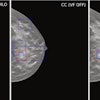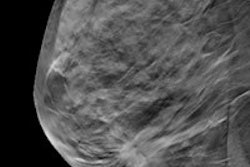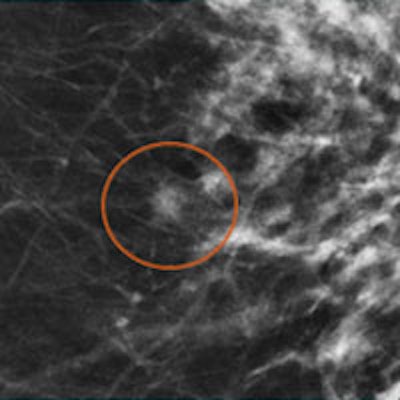
Synthetic 2D images can bring additional value to digital breast tomosynthesis (DBT), overcome the limitation in comparison with prior studies without additional radiation dose exposure, and lead to no increase in exam times, Italian researchers found.
This is especially true in assessing distortion and asymmetries and applies in screening and diagnostic settings, they added.
DBT may be used for screening and diagnostic mammography, but these days it often requires the addition of simultaneous digital mammography, according to Dr. Valentina Iotti, a radiologist at the department of diagnostic radiology at Azienda Ospedaliera Arcispedale Santa Maria Nuova - IRCCS in Reggio Emilia.
The combination allows for comparison with prior studies and the evaluation of microcalcification clusters. Limitations of the pairing include approximately double the radiation dose and a potential increase in examination and interpretation times, she noted in an ECR 2015 presentation.
"So synthetic 2D imaging has been developed to overcome this limitation by reconstructing a 2D image from the information acquired during DBT data acquisition procedure," she said.
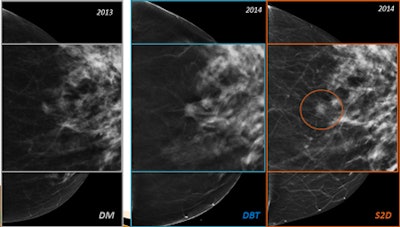 A 60-year-old woman with 7-mm invasive ductal carcinoma in the left breast. Left: Digital mammography. Center: DBT. Right: Synthetic 2D. All images courtesy of Dr. Valentina Iotti.
A 60-year-old woman with 7-mm invasive ductal carcinoma in the left breast. Left: Digital mammography. Center: DBT. Right: Synthetic 2D. All images courtesy of Dr. Valentina Iotti.The purpose of her group's study was to evaluate the perceived diagnostic value of reconstructed, synthetic 2D images when added to DBT (GE Healthcare, SenoClaire). They retrospectively reviewed 100 DBT exams with 11 proven breast malignancies. Two independent breast radiologists (20 years and 1.5 years of experience) assessed the cases after patient management was completed. To simulate screening and diagnostic situations, the readers were blinded on clinical history for 50 patients and unblinded for the other 50.
Readings were performed with DBT alone, then with added synthetic 2D images. Perceived diagnostic value of synthetic 2D images was rated on a three-step scale: 0 to +2 for the blinded group and -1 to +1 for unblinded cases to determine whether synthetic 2D images might be misleading.
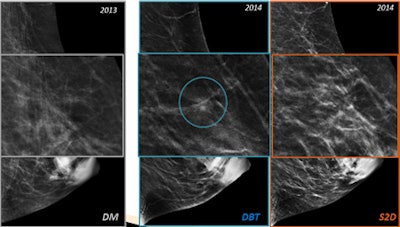 A 48-year-old woman. Synthetic 2D was able to exclude a potential tiny distortion. Left: Digital mammography. Center: DBT. Right: Synthetic 2D.
A 48-year-old woman. Synthetic 2D was able to exclude a potential tiny distortion. Left: Digital mammography. Center: DBT. Right: Synthetic 2D.They found in a screening setup the synthetic 2D images may increase the diagnostic confidence in 38% of readings, which is especially beneficial for less experienced readers. In a diagnostic setup, synthetic 2D images increased confidence in 45% of readings and only decreased confidence in 8% of readings. Overall, synthetic 2D added diagnostic value in 41% of readings, especially in assessing distortion and asymmetries. It was considered misleading in only 4% of readings.
Iotti advocates using synthetic 2D imaging all the time. "It's costless, it doesn't require any addition of radiation exposure, and 'sometimes' (41%!) it's useful. So why not?" she said in an interview with AuntMinnieEurope.com.
As a result of the study, her institution is beginning to automatically reconstruct 2D synethic images and store them in their PACS.
"[Synthetic] 2D could be useful especially in the first approach with tomo, because it's closer to what experts radiologists are used to, and it's one perspective more to consider for the beginners, [who are] usually less self-confident," she said. "We believe that also in a screening program, tomo will soon replace digital mammography, and 2D could be perfect for the 'first glance' -- of course without being considered enough to avoid a complete scroll of all images."
In future research, in the screening setting, Iotti and her colleagues will study the comparison between DBT plus digital mammography and DBT plus synthetic 2D in a clinical trial.


